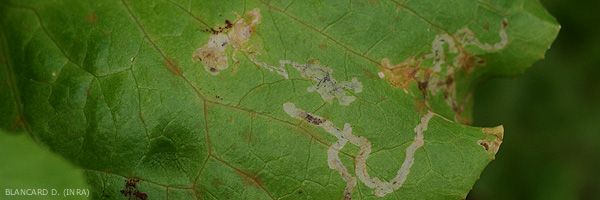
Damage due to predators
Several predators are responsible for more or less orange alterations on the leaf blades of salads. We have deliberately integrated these alterations under this heading because they sometimes lead to confusion with the other symptoms studied in this section.
This is the case with the damage of certain slugs ( Deroceras reticulatum , Deroceras laeve , Arion hortensis ) very locally browsing the leaf tissues of the blade and the ribs (figure 1). The observation of these predators on or in the environment of salads should allow you to confirm this hypothesis very quickly (figure 2).
Various insects also cause tiny orange changes, often damaging when there are many. The leafminers cause multiple punctuations fat to orange, slightly raised, as a result of their nutritional bites (Figure 3). There are also sinuous mines located mainly on old leaves (Figure 4). Several species of Liriomyza can cause such symptoms. In France, it is mainly Liriomyza huidobrensis which manifests itself in salads. Leafminers are small flies a few millimeters long (around 2 mm), predominantly black in color (Figure 5). Their tiny yellow larvae move through the thickness of the blade causing mines.
The thrips cause tiny necrosis orange, elongated, metallic sheen (Figures 6 and 7). These can be located on or between the ribs. Little damaging in France, thrips can cause serious damage in tropical areas; this is the case with Thrips palmi . Thrips are tiny insects about 1 mm long, of variable color (black, yellowish, amber yellow ...) that can sometimes be seen with the naked eye. Adults are quite mobile. A few species ( Frankliniella occidentalis in France) are vectors of a serious virus of lettuce: the virus of bronzed tomato disease (TSWV). You can view the symptoms caused by this virus in the sheet Viruses and virus complexes .





